An F1b Labradoodle has one first generation Labradoodle parent, and one purebred Poodle or Labrador parent – usually a Poodle. On average, this means they look and behave more like a Poodle than a Labrador. The physical and temperament differences between a purebred Lab and an F1b Labradoodle are more pronounced when Miniature Poodles are used than when Standard Poodles are used. And choosing an F1b Labradoodle puppy from health tested parents who you’ve met and like is the best route to puppy satisfaction!
F1b Labradoodle dogs are sometimes also described as an Fb1 Labradoodle, or even a Labradoodle F1 b. The F stands for filial, the number shows how many generations separate the puppy from their purebred ancestor and the b show that they have been backcrossed. This is a popular strategy for fixing particular traits such as a non-shedding coat in the next generation of puppies. But it doesn’t always work out like that!
Contents
- The meaning behind the F1b Labradoodle code
- The benefits of backcrossing
- F1b Labradoodle traits
- F1b Labradoodle puppies
Have you seen an F1b Labradoodle for sale or adoption, and wondered what the extra letters stand for? In this comprehensive guide to Labradoodle backcrossing, I answer the question ‘what does F1b Labradoodle mean?’ and look at what it’s like to own one.
What is an F1b Labradoodle?
An F1b Labradoodle puppy is the offspring of one F1 Labradoodle parent and either a purebred Poodle or purebred Labrador Retriever. What does F1b stand for?
What does F1b stand for?
When buying a Labradoodle puppy it’s useful to understand how they are labelled. They reveal important details about what it is you’re actually going to get!
- A first generation Labradoodle from one Labrador parent and one Poodle parent is an F1 Labradoodle. The F stands for ‘filial’, which is a word to describe the relationship between a parent and their offspring.
- The number following the F describes how many generations separate a puppy from their most recent purebred ancestor. F1 means that a puppy has at least one purebred parent. F2 means that they have purebred grandparents, but mixed breed parents, and so on.
- And finally, the b stands for ‘back cross’. Back crossing is when you mate a mixed breed dog to a pedigree dog from one of their ancestral breeds. In this case, F1b puppies are the result of mating an F1 Labradoodle to either a Labrador or Poodle. But you can also get F2b Labradoodles and so on.
What about an F1bb Labradoodle?
It’s even possible to stack layers of back crossing. So an F1bb Labradoodle is the puppy of an F1b Labradoodle back crossed to a purebred Poodle or Labrador again. They have one purebred parent, three purebred grandparents, and eight purebred great grandparents.
Important note
F1, F1b, F1bb etc all refer to mixed breed dogs. They are ways of describing the pattern of mixing that took place. So, you’ll never get an F1b Poodle (because Poodles aren’t a mixed breed), and there’s no such thing as an F1b breed of dog. But why do breeders pursue such elaborate permutations of mixed breeding? Does it actually produce better puppies? Let’s turn to that next!
Why breed F1b dogs?
Breeders use back crossing to increase the probability of puppies inheriting specific traits. An F1b Labradoodle can have either a Poodle parent or a Labrador parent, but in practice they’re almost always the result of a Labradoodle back crossed to a Poodle again. The reason is to increase the probability of the F1b generation having non-shedding coats. F1b Mini Labradoodle litters are more likely to be small, assuming Miniature Poodles were used for each generation.
However, it’s important to bear in mind that traits like a non-shedding coat aren’t inherited in an entirely predictable way. An F1 Labradoodle has 50% Labrador genes and 50% Poodle genes. They will inherit genes governing coat length, texture and shedding from both of their parents, and they may or may not shed.
An F1b Labradoodle with a purebred Poodle parent has at least 50% Poodle genes, inherited from their parent parent. Their Labradoodle parent will also provide copies of half of their own genes, selected at random. So an F1b Labradoodle can be between 0% and 50% Labrador, and between 50% and 100% Poodle. Statistically, most end up somewhere in the middle: about 75% Poodle and 25% Labrador. Importantly, their Labrador inheritance could still result in them having a shedding coat.
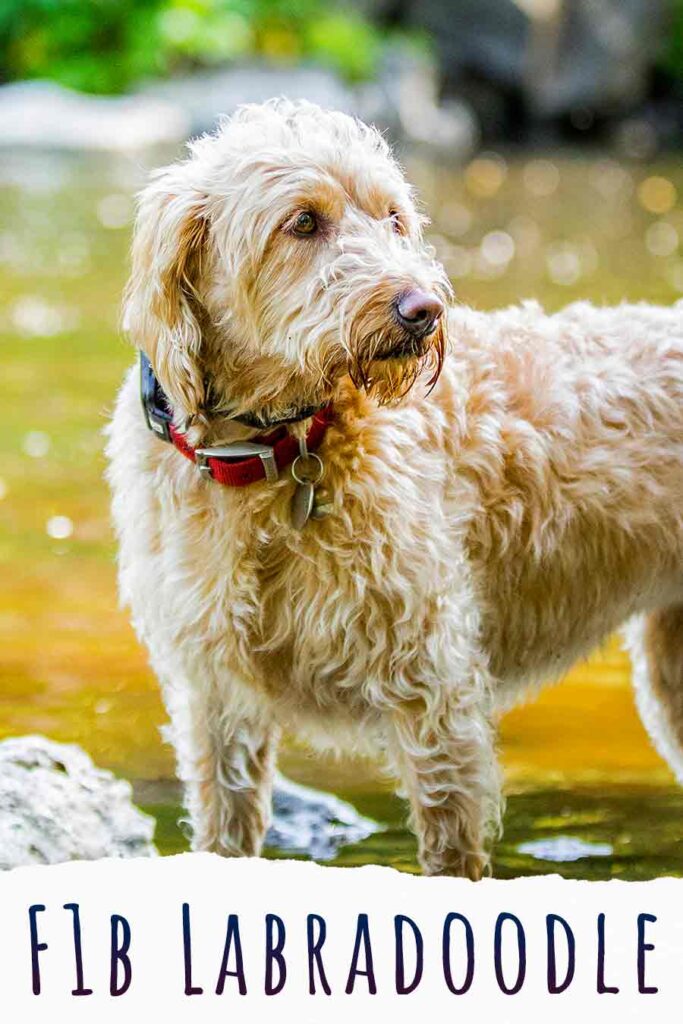
How big do F1b Labradoodles get?
Size is one of the most potentially variable Labradoodle qualities of all. In theory a first generation Labradoodle can weigh anything from 40 to 80 pounds, which is a pretty wide range!
Since Poodles are smaller on average than Labradors, creating an F1b Labradoodle generation increases the odds of the puppies falling at the top or bottom of that range, depending on whether a Labrador or Poodle parent is used.
What about an F1b Mini Labradoodle?
Mini Labradoodles are increasingly popular. They are the result of crossing a Labrador Retriever with a Miniature Poodle. Mini Poodles usually weigh between 10 and 15 pounds, which means the potential weight range for an F1 Miniature Poodle is staggeringly wide. But, crossing a petite F1 Mini Labradoodle with another Miniature Poodle greatly increases the probability of reliably small F1b Mini Labradoodle puppies. This is desirable for breeders and puppy buyers because most people prefer to know in advance how big their puppy is likely to get!
What is an F1b Labradoodle like as a pet – temperament and training
Creating an F1b generation can also increase the odds of a Labradoodle having a very Labrador-y or Poodle-ish personality. For Standard Labradoodles, this might not actually make much difference. Labradors and Poodles were both originally gundogs, and they are both active, clever, open to meeting new people, and responsive to training, If anything the Poodle may be slightly less keen to socialize with other dogs, and slightly more likely to display watchdog behaviors at home (for example barking at visitors and passers by). However, Miniature Poodle temperament is distinctly different from Labrador and Standard Poodle temperament in several ways. They are more likely to
- display non-social fear (for example of vehicles, thunder or fireworks)
- be touch sensitive
- suffer separation anxiety
- and behave aggressively or threateningly to other dogs in the same household (dog rivalry).
So creating an F1b generation of Mini Labradoodle puppies increases the odds of dogs with these traits. A good breeder will choose their breeding dogs carefully to avoid passing on problem behaviors, and be honest about the temperaments of their puppies’ sire and dam.
Are F1b Labradoodles hypoallergenic?
We’ve already touched on why back crossing is popular as a way of improving the odds of puppies with non-shedding coats. Unfortunately it doesn’t improve the odds of F1b Labradoodles being hypoallergenic though. In fact, there is no convincing evidence that any breed of dog is truly hypoallergenic, including pedigree Poodles and other non-shedding breeds.
The proteins which trigger peoples’ allergic reactions to dogs are mainly produced in their saliva, and to a lesser extent in their sweat and urine. A non-shedding coat doesn’t change the presence of those proteins.
So how do some people with allergies tolerate Labradoodles? Well, the allergenic proteins in their saliva, sweat and urine are actually a family of proteins called Can F 1 proteins. And there is a lot of subtle variation in the exact molecular composition of the Can F 1 proteins individual dogs produce. Likewise, there is lots of subtle variation in the immune systems of dog-allergic people. So when a dog allergic person finds a dog they don’t react to, it’s just lucky chemistry!
F1b vs F1 Labradoodle
Why choose an F1b Labradoodle over an F1 Labradoodle? Well this comes down to what kind of dogs you’re hoping to end up with. Unfortunately designer dogs like Labradoodles are very vulnerable to exploitation by puppy farms.
Ultimately, the exact size, coat, and temperament of either generation is less consistent than that of a purebred Lab or Poodle. So if securing, or avoiding, any of these qualities is important to you, then you’ll probably be better off with a pedigree dog, than gambling on an F1b vs F1 Labradoodle.
Choosing between F1b Labradoodle puppies
We’ve seen that F1b Labradoodles can still be very variable. If something like size, a non-shedding coat, or particular character traits is important to you, how do you spot the puppy which has inherited that perfect combination?
Unfortunately, puppy behavior is a very poor predictor of adult F1b dog temperament. Lots of factors, like the environment the breeder raises them in, the age they leave mom, how much you socialize them before 12 weeks old, and training will also shape their grown up personality. You’re likely to get a better idea of what puppies will be like by insisting on meeting both of their parents.
Physical features like coat texture aren’t always apparent in puppies either. Puppies are born with a soft puppy coat which is replaced by a coarser adult coat at about 6 months old. It’s not unusual for the smallest puppy in the whelping pen to turn out to be the biggest sibling by adulthood either! Your breeder may be able to offer some predictions about puppies’ size and character based on their experience and the time they have spent with the litter so far. But it’s important to take their forecast with a pinch of salt.
How do I find F1b Labradoodle puppies for sale near me?
It’s a sad fact that when it comes to breeding, designer dogs like F1b Labradoodles are frequently victims of their own success. Puppy farmers keep breeding dogs and their puppies in poor conditions, but charge high prices, to achieve maximum profit. Puppies raised on puppy farms often have hereditary diseases which could have been avoided by genetic testing of their parents. They are also more likely to come home with parasitic infections. Behavioral problems resulting from a lack of socialization or being sold too young are commonplace too.
Look for breeders who have been recommended by someone you know, or who can provide references from previous puppy buyers. Ask lots of questions about how their puppies are raised. And insist on seeing the results of health tests for both parents. A good breeder will be aware of the dangers facing Labradoodles from puppy farms, and be happy that you care too. This article can help you spot a bad breeder and give them a wide berth.
The Labrador Site Founder
Pippa Mattinson is the best selling author of The Happy Puppy Handbook, the Labrador Handbook, Choosing The Perfect Puppy, and Total Recall.
She is also the founder of the Gundog Trust and the Dogsnet Online Training Program
Pippa's online training courses were launched in 2019 and you can find the latest course dates on the Dogsnet website

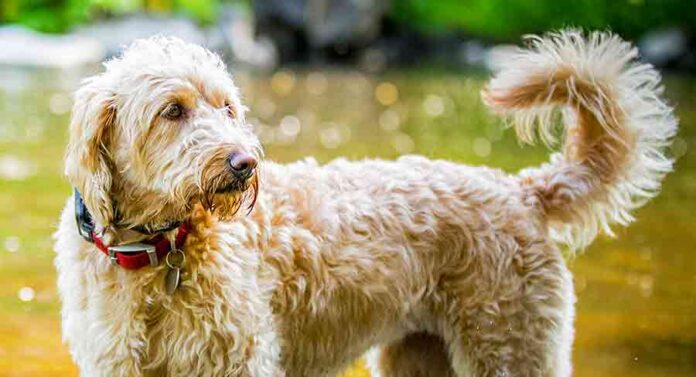




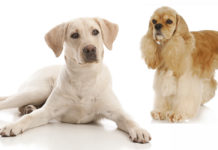
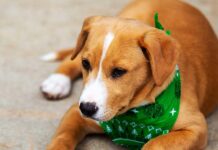
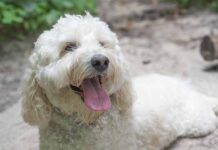
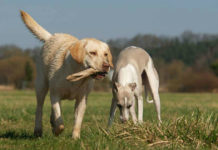
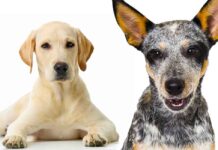








I have an F1b labradoodle and you would think she is 100% poodle. Look wise and personality wise, very sassy too! She’s my best friend:) She has bad separation anxiety, very very smart, acts like a human, super curly white hair but all fluffy when I wash and blow dry and brush her. I even gave her a clean face!